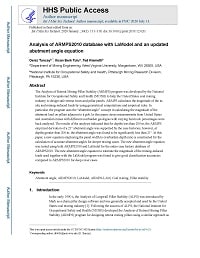Mining Publication: Analysis of ARMPS2010 Database with LaModel and an Updated Abutment Angle Equation
Original creation date: January 2020
Authors: D Tuncay, I Tulu, T Klemetti
The Analysis of Retreat Mining Pillar Stability (ARMPS) program was developed by the National Institute for Occupational Safety and Health (NIOSH) to help the United States coal mining industry to design safe retreat room-and-pillar panels. ARMPS calculates the magnitude of the in-situ and mining-induced loads by using geometrical computations and empirical rules. In particular, the program uses the “abutment angle” concept in calculating the magnitude of the abutment load on pillars adjacent to a gob. In this paper, stress measurements from United States and Australian mines with different overburden geologies with varying hard rock percentages were back analyzed. The results of the analyses indicated that for depths less than 200 m, the ARMPS empirical derivation of a 21° abutment angle was supported by the case histories; however, at depths greater than 200 m, the abutment angle was found to be significantly less than 21°. In this paper, a new equation employing the panel width to overburden depth ratio is constructed for the calculation of accurate abutment angles for deeper mining cases. The new abutment angle equation was tested using both ARMPS2010 and LaModel for the entire case history database of ARMPS2010. The new abutment angle equation to estimate the magnitude of the mining-induced loads used together with the LaModel program was found to give good classification accuracies compared to ARMPS2010 for deep cover cases.

- ARMPS - Analysis of Retreat Mining Pillar Stability - 6.2.02
- Calibrating the LaModel Program for Deep Cover Pillar Retreat Coal Mining
- Deep Cover Pillar Extraction in the U.S. Coalfields
- Deep Cover Pillar Recovery in the US
- Effect of Discontinuity Dip Direction on Hard Rock Pillar Strength
- Ground Control Overview
- Pillar Design and Strategies for Retreat Mining
- Proceedings: New Technology for Ground Control in Retreat Mining
- The State-of-the-Art in Coal Pillar Design
- Technology News 464 - Analysis of Retreat Mining Pillar Stability (ARMPS): Version 4.0 for Windows